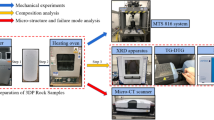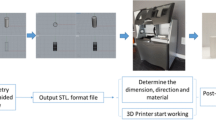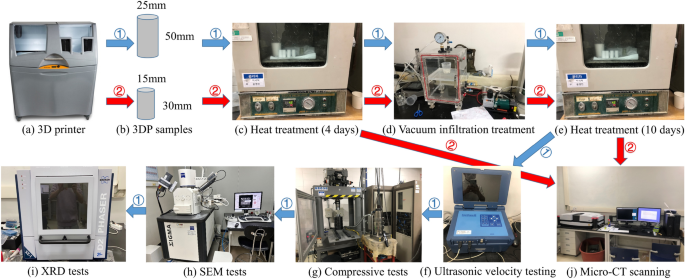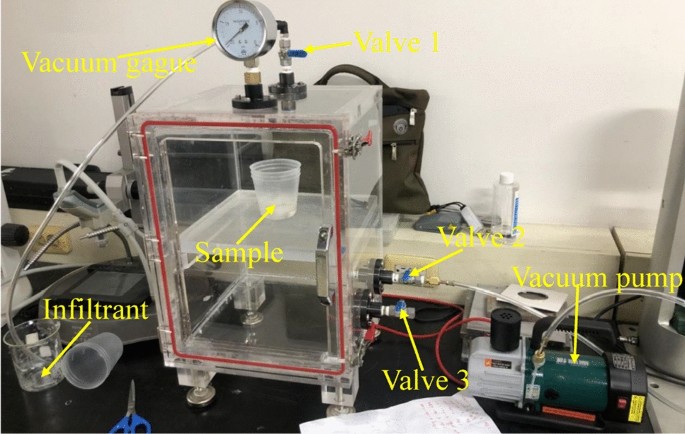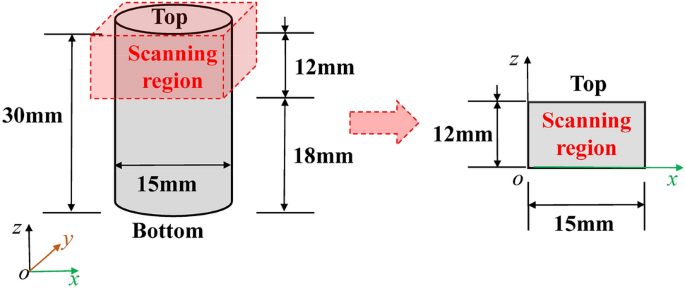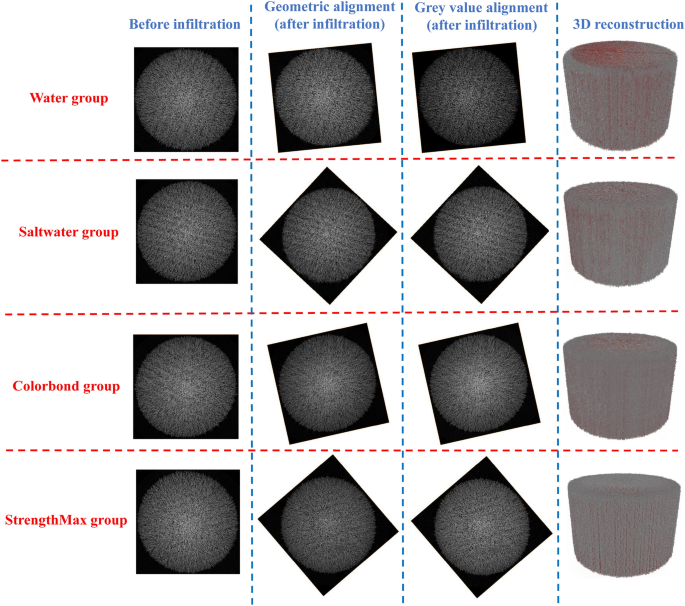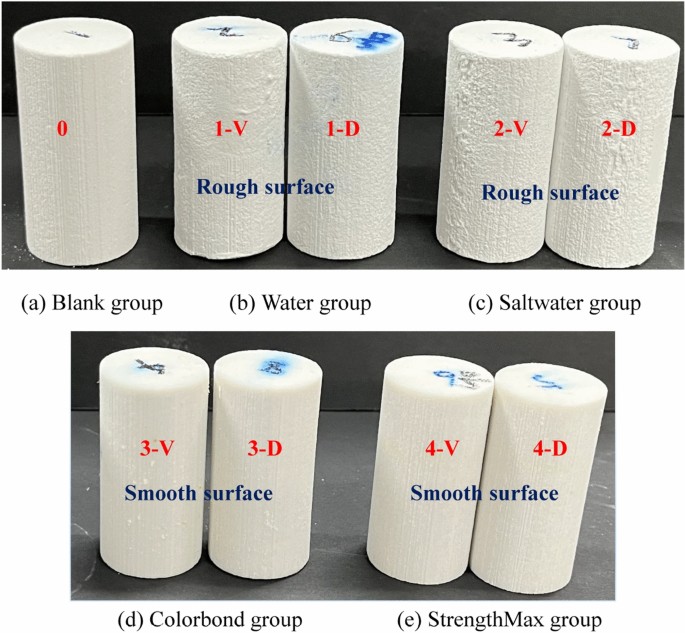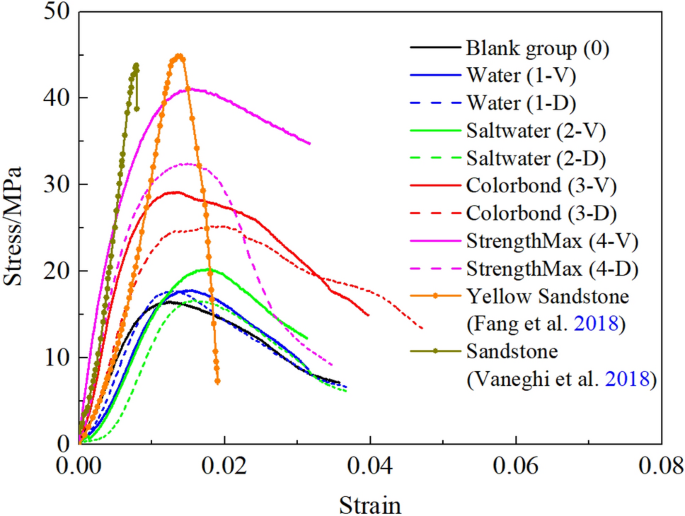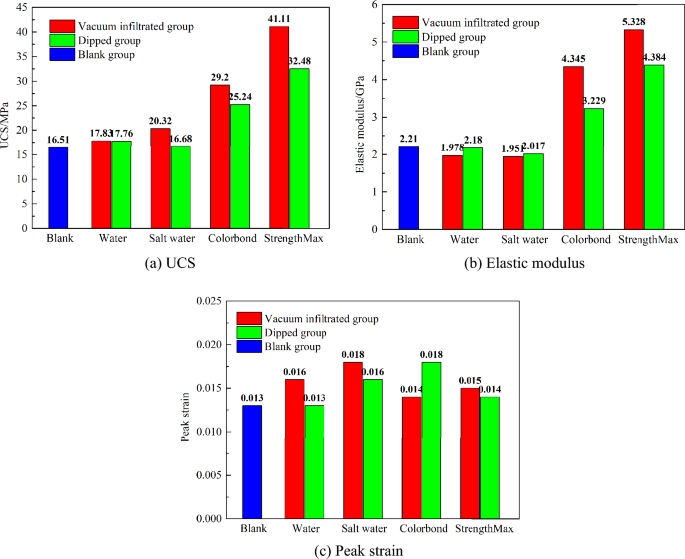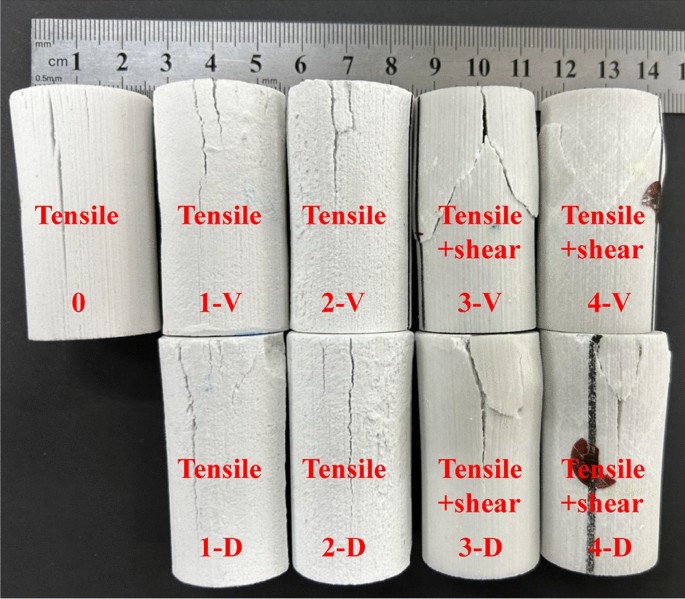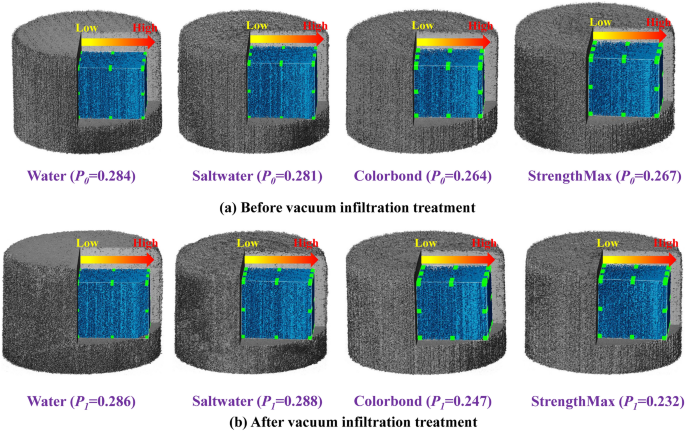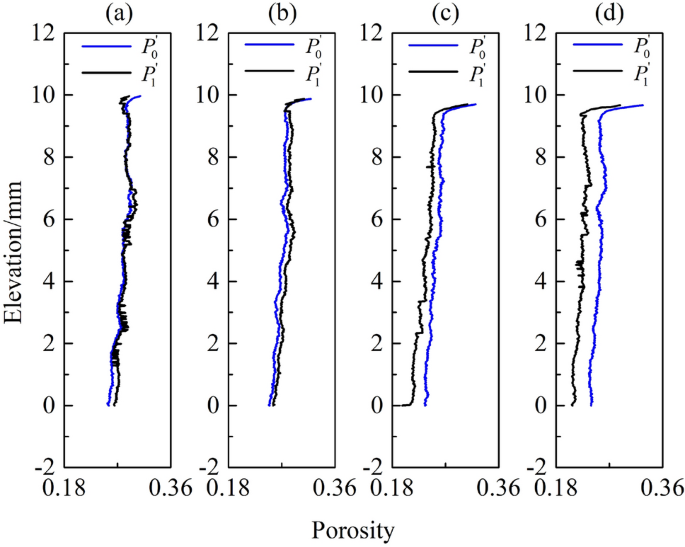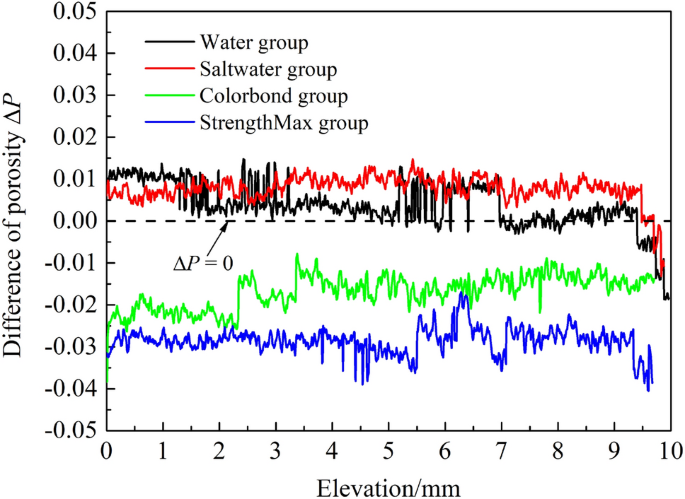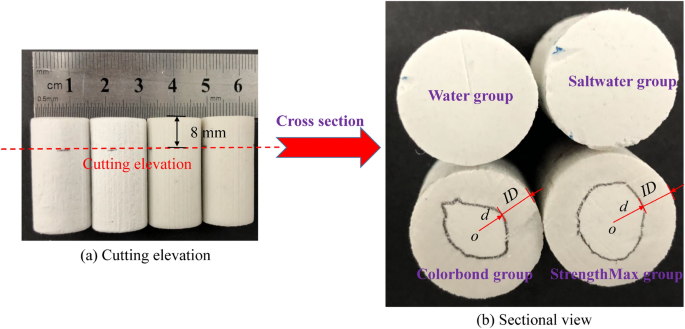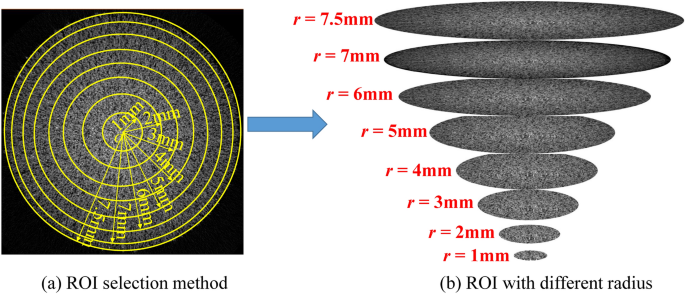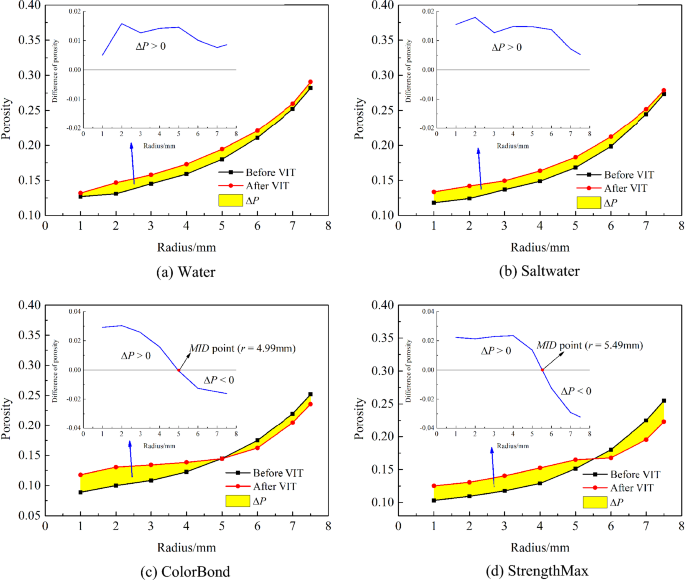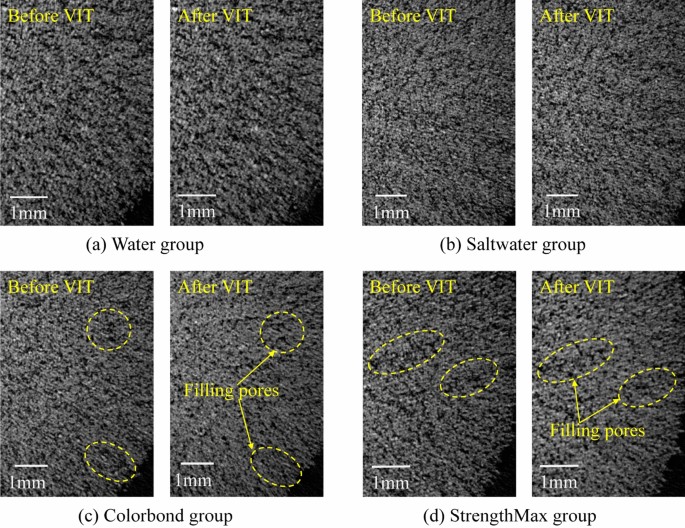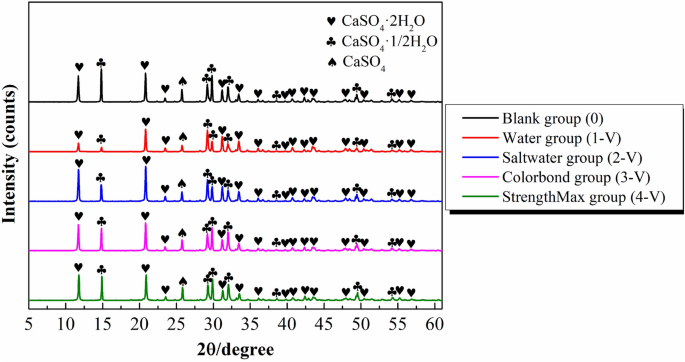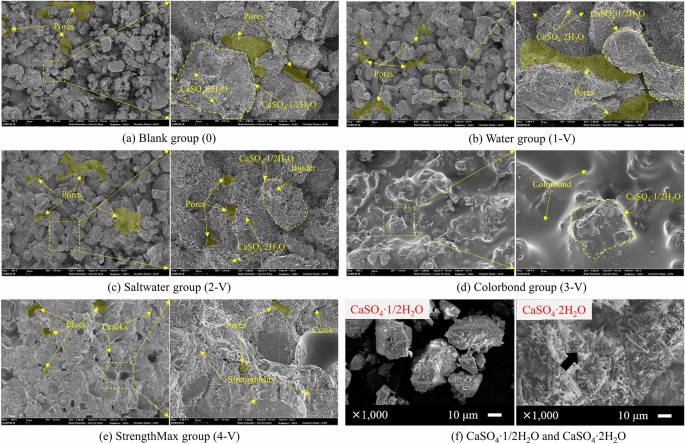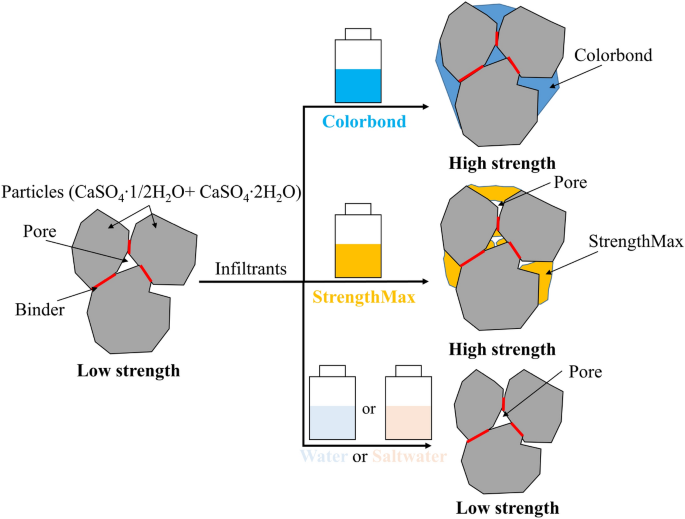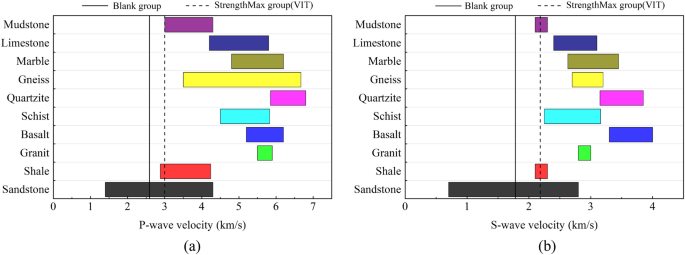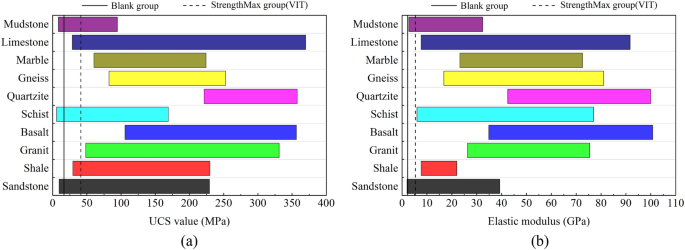Abstract
Three-dimensional printing (3DP) technology has shown great potential in rock mechanics and mining engineering due to its ability to create complex and customized objects with high precision and accuracy. At present, an emerging research focus is improving the mechanical properties of 3D-printed samples, which originally has low strength and stiffness, to match those of natural rocks. The objective of this study was to investigate the effectiveness of different post-treatments on the strength enhancement of 3D-printed gypsum samples. To achieve this goal, 3D-printed gypsum samples were subjected to different post-treatments including dipped infiltration treatment and vacuum infiltration treatment using different infiltrants: water, saltwater, ColorBond, and StrengthMax. Subsequently, each sample was subjected to ultrasonic wave velocity testing and uniaxial compression experiments to characterize their mechanical properties, CT scans to investigate their microstructural characteristics. Additionally, X-ray Diffraction (XRD) and Scanning Electron Microscope (SEM) tests were conducted to explore the underlying reasons for changes in macroscopic strength. Finally, the physical characteristics and mechanical properties of untreated and post-processed 3D-printed gypsum samples were compared with natural rocks. The results showed that the strength of samples treated with water and saltwater was much lower than that of those treated with ColorBond and StrengthMax, while the porosity was the opposite. In water-treated and saltwater-treated samples, water or saltwater treatment can alter particle characteristics, but weak adhesive bonding and numerous pores result in low mechanical strength. Samples treated with Colorbond or StrengthMax exhibit improved strength due to effective gap filling and cohesive structure formation, with StrengthMax-treated samples showing higher strength despite having more pores than Colorbond-treated ones. Moreover, the physical and mechanical properties of these treated samples matched a wider range of natural rock types compared to the untreated samples.
Highlights
-
This study investigates the impact of different post-treatments and infiltrants on the physical and mechanical properties of 3D-printed gypsum samples.
-
A novel method is proposed in this study to quantitatively evaluate the degree of infiltration by comparing the changes in porosity before and after vacuum infiltration of 3D-printed samples based on 2D CT images.
-
The study provides an in-depth analysis of the mechanisms responsible for the macroscopic strength enhancement in 3D-printed samples after vacuum infiltration treatment.
-
Vacuum infiltration treatment using StrengthMax significantly improves the physical and mechanical properties of 3D-printed gypsum rocks, allowing them to replicate a wider variety of natural rocks compared to untreated samples.
Similar content being viewed by others
Avoid common mistakes on your manuscript.
1 Introduction
The application of three-dimensional printing (3DP) technology in rock mechanics research has become popular due to its capability of producing rock-like models of various shapes and sizes that closely resemble actual rocks. These models can be quickly, accurately, and inexpensively produced in large batches, enabling researchers to gain deeper insights into the physical and mechanical properties of natural rocks (Gao et al. 2021). 3D printed samples offer advantages over molded samples, including the ability to create intricate designs, rapid prototyping, reduced material waste, and lower tooling costs, while providing greater design flexibility and improved mechanical properties in certain cases. With the development of 3DP technology, there are now various types of printing materials available. In the field of rock mechanics research, the main printing materials used are as follows: gypsum powder (Fereshtenejad et al. 2021; Fereshtenejad and Song 2016; Jiang et al. 2016a, b, c; Jiang and Song 2018; Kong et al. 2018; Sharafisafa et al. 2018a, b; Wu et al. 2020), photosensitive resin (Li et al. 2021; Suzuki et al. 2019; Zhou et al. 2019, 2020), sandstone powder (Osinga et al. 2015, Wang et al. 2022; Yu et al. 2021; Zhang and Li 2022), polylactic acid (PLA) (Jiang and Zhao 2015; Jiang et al. 2016a, b, c; Li et al. 2022a, b; Zhou and Zhu 2018), and cement-based materials (Feng et al. 2019, 2022; Mei et al. 2022). A series of mechanical experiments have been conducted on the 3D-printed rocks using the aforementioned printing materials, which include mechanical properties testing (Fereshtenejad and Song 2016, Jiang et al. 2016a, b, c, Kong et al. 2018, Osinga et al. 2015, Sharafisafa et al. 2018a, b, Wang et al. 2022, Wu et al. 2020, Zhou and Zhu 2018), crack propagation and failure mechanisms (Jiang et al. 2016a, b, c; Sharafisafa et al. 2018a, b; Sharafisafa et al. 2019; Yu et al. 2021; Zhou et al. 2019, 2020), shear and permeability characteristics (Fereshtenejad et al. 2021; Li et al. 2021; Suzuki et al. 2019; Wang et al. 2020), and physical modeling (Feng et al. 2019; Jiang and Song 2018; Li et al. 2022a, b; Song et al. 2018). The relative merits and applications of printing materials are tabulated in Table 1. Compared to other printing materials, gypsum powder is widely regarded as an effective material for producing rock-like samples (Kong et al. 2018; Wu et al. 2020), since it has composition and structure that closely resemble those of natural rocks. It also has the advantage of producing samples with a high level of precision at low cost. However, a significant limitation of 3D-printed gypsum rocks is that they have comparatively low strength and high ductility, which differs from the typical properties of natural rocks. Consequently, enhancing the mechanical properties of 3D-printed samples to match the strength and stiffness of natural rocks has emerged as a key research focus for 3DP technology applications in rock mechanics.
To improve the strength and stiffness of 3D-printed gypsum samples, two approaches can be considered: the optimization of 3D printing parameters and the post-processing of printed samples. The selection of optimal 3D printing parameters involves setting different printing parameters including printing directions (Fereshtenejad and Song 2016; Hamano et al. 2021; He et al. 2020), layer thicknesses (Farzadi et al. 2014; Fereshtenejad and Song 2016), binder saturation levels (Fereshtenejad and Song 2016; Liu et al. 2019), and printing delay times (Farzadi et al. 2015), to develop the strength and stiffness of 3D-printed gypsum samples. The mechanical properties of 3D-printed gypsum samples can vary significantly depending on the printing direction which is primarily determined by the bedding direction and movement of the printer head. This can have a significant impact on not only the mechanical anisotropy but also the strength and stiffness of the 3D-printed gypsum samples, as demonstrated in our previous research (Shao et al. 2023). While some studies (Farzadi et al. 2014; Fereshtenejad and Song 2016) have reported that changing the layer thickness can also affect the strength of 3D-printed gypsum samples, its impact is relatively small compared to other printing parameters. The level of binder saturation is a crucial factor affecting the strength and stiffness of 3D-printed gypsum samples, and increasing the level of binder saturation has been reported to enhance the strength of 3D-printed samples (Fereshtenejad and Song 2016; Liu et al. 2019). The observed enhancement can be attributed to a chemical reaction between the water present in the binder and the hemihydrate calcium sulfate (CaSO4·1/2H2O) in the raw powder, resulting in the formation of high-strength dihydrate calcium sulfate (CaSO4·2H2O) and bonding the particles together to create a highly strong interlocking structure (Hamano et al. 2021). In addition, print delay time is also one of the factors affecting the mechanical properties of 3D-printed gypsum samples. Farzadi et al. (2015) investigated the effects of four different print delay times (50,100,300 and 500 ms) on the physical and mechanical properties of 3D-printed gypsum samples. The results showed that the compressive strength, toughness and elastic modulus of samples printed with a delay of 300 ms were higher than those of other samples. However, it should be noted that even with optimal printing parameters, the strength and stiffness of the 3D-printed gypsum samples remain relatively low due to limitations and defects in both the printing material and the 3D printer itself, which makes these samples difficult to use as accurate replications of natural rock.
Compared with optimal printing parameter settings, the post-processing of 3D-printed samples has a more significant impact on the strength enhancement of 3D-printed gypsum samples. The common post-treatments for strength enhancement include heat treatment (Fereshtenejad and Song 2016; Liu et al. 2019), dipped infiltration treatment (Shah et al. 2020; Shakor et al. 2022), and vacuum infiltration treatment ( Kong et al. 2019, Wang et al. 2021). While heat treatment has been shown to improve mechanical properties in some studies (Liu et al. 2019), excessively high temperature or prolonged heating times can have a negative impact on the mechanical properties of samples. Therefore, optimal heating conditions may vary between researchers. For example, Fereshtenejad and Song (2016) recommended heating at 150 °C for 60 min, while Zhou et al. (2013) suggested a temperature of 200 °C for 30 min as optimal. Placing 3D-printed gypsum samples in a fast-curing infiltrant for a certain time is also an effective method to improve mechanical properties. There are many types of infiltrants used to enhance the strength of 3D-printed gypsum samples, including water (Mandal and Basu 2018), salt water (Rodríguez-González et al. 2022), wax (Ishutov and Hasiuk 2019; Shah et al. 2020), and resin materials (Kong et al. 2019, Wang et al. 2021, Wu et al. 2020). Wang et al. (2021) demonstrated that dipping 3D-printed gypsum samples in ColorBond (manufactured by 3D Systems, Inc.) results in excellent mechanical properties. This treatment reduced surface roughness, mitigated the step effect, and enhanced the strength of powder-based models to a level comparable to that of functional models. In fact, the degree of infiltration is a crucial factor in this treatment that directly affects the mechanical properties of 3D-printed gypsum samples. Compared to dip infiltration treatment, vacuum infiltration treatment can maximize the degree of infiltration, resulting in a significant improvement in the strength of the post-processed samples (Ayres et al. 2019). Wu et al. (2020) utilized the vacuum infiltration technology, with ColorBond as the infiltrant, to increase the strength of 3D-printed gypsum samples to 56.7 MPa. Through this approach, high-stress soft rocks could be replicated using 3D-printed gypsum samples.
Previous studies have consistently demonstrated that vacuum infiltration treatment can significantly enhance the physical and mechanical properties of 3D-printed gypsum samples. However, further research is necessary to determine the ideal infiltrant material, evaluate the impact of vacuum infiltration on the pore structure and porosity of 3D-printed gypsum samples, quantitatively measure the degree of infiltration, and uncover the underlying reasons for the macroscopic strength improvement of post-treated samples. To address these research gaps, this study investigates the effects of various infiltration methods and infiltrant materials on the mechanical and microstructural properties of 3D-printed gypsum samples. This investigation includes ultrasonic wave velocity tests, uniaxial compression tests, X-ray diffraction (XRD) tests, scanning electron microscopy (SEM) tests, and Micro-CT scanning. We analyze the ultrasonic wave velocity characteristics, mechanical properties, compositional changes, and microstructural properties of 3D-printed samples before and after vacuum infiltration treatment. The results help us identify the most optimal infiltrant material and effective post-processing method, while also revealing the underlying reasons for the macroscopic strength enhancement in 3D-printed samples after vacuum infiltration treatment. Furthermore, we compare the enhanced mechanical properties of the post-processed samples with those found in natural rocks.
2 Experiments and Methods
2.1 Experimental Scheme and Equipment
The experimental process consists of 3D-printed samples preparation (Fig. 1b), post-processing (Fig. 1c-e), ultrasonic wave velocity and mechanical properties measurement (Fig. 1f and g), SEM tests (Fig. 1h), XRD tests (Fig. 1i), and CT scanning (Fig. 1j). Two different sizes of 3D-printed gypsum samples, Φ 25 mm × 50 mm and Φ 15 mm × 30 mm, were manufactured using a gypsum powder-based 3D printer. Layer thickness and binder saturation level were set to 0.1 mm and 100%, respectively, and all samples were fabricated in conjunction with the movement direction of the printer head. The large-sized 3D-printed gypsum samples were subjected to uniaxial compression tests and small-sized samples were subjected to CT scanning tests. The experiment processes for each sample are illustrated in red and blue arrows in Fig. 1, respectively. All 3D-printed samples were put into a drying oven at a constant temperature of 40 °C for 4 days to ensure consistent sample quality and physical behavior. After the first stage of heat treatment, the samples were treated by different infiltration treatments, including dipped infiltration and vacuum infiltration. For the vacuum infiltration, the vacuum infiltration equipment shown in Fig. 1d was used. Liu et al. (2019) have reported that the mechanical properties and physical characteristics of 3D-printed gypsum samples remain stable after being placed in an oven at 40 ℃ for 14 days. Therefore, the infiltration-treated samples were then kept in the drying oven again for 10 days, for the second stage of heat treatment, before conducting the uniaxial compressive tests and CT scanning tests. It should be noted that the small-sized samples were scanned by Micro-CT after both the first and second heat treatment to compare the microstructural variation before and after the vacuum infiltration treatment, as shown in Fig. 1j. After undergoing uniaxial compression testing, large-sized samples were subject to SEM and XRD tests, aiming to detect alterations in sample composition and internal microstructure, as depicted in Fig. 1h and i.
2.2 Vacuum Infiltration Equipment and Post-Processing
In this study, a specially designed vacuum infiltration equipment was utilized to ensure pump, a vacuum chamber and four valves (valves 1 to 4), as shown in Fig. 2. The vacuum chamber is connected to the infiltrant material, vacuum pump, and atmospheric pressure through valve 1, valve 2, and valve 3, respectively. The vacuum infiltration treatment is conducted through the following steps: First, a plastic cup containing the 3D-printed samples is placed in the closed vacuum chamber of which all valves are closed. Then, valve 2 is opened and the vacuum pump is operated to create a low-pressure vacuum environment (− 20 kPa) inside the vacuum chamber, which is maintained for 24 h. Afterward, valve 1 is opened to allow the infiltrant to flow into the plastic cup within the vacuum chamber. Once the infiltrant fully covers the sample, valve 1 is immediately closed and valve 2 is opened again, with the vacuum pump operating, to maintain a vacuum pressure of − 20 kPa for 5 min. Finally, after 5 min, valve 2 is closed, the vacuum pump is turned off, and valve 3 is opened to make the infiltrant permeate into the internal pores of the samples by backward atmospheric pressure. After bubbling ceases on the surface of the samples, excess infiltrant is wiped off, and the 3D-printed samples are dried in a drying oven at 40 °C for 10 days before undergoing uniaxial compression tests or CT scanning experiments.
Four different infiltrants including water, saltwater, ColorBond and StrengthMax (manufactured by 3D Systems, Inc.) were adopted in this study, as shown in Table 2. The viscosity of infiltrants in ascending order is water, saltwater, ColorBond and StrengthMax. To investigate the effects of different post-treatments and infiltrants on the mechanical properties of 3D-printed samples, nine groups with the size of Φ 25 mm × 50 mm were manufactured to subject different post-treatments using different infiltrants. To enhance the reliability of the data, we utilized two samples for each group, presenting their average values as the final data. The detailed post-processing schemes for different sizes of 3D-printed gypsum samples using different infiltrants are shown in Table 3, where signs “V” and “D” represent vacuum infiltration treatment and dipped infiltration treatment, respectively. The numbers 1, 2, 3 and 4 denote different infiltrants, which are water, saltwater, ColorBond and StrengthMax, respectively. For example, 1-V and 3-D each indicate 3D-printed samples treated by water using vacuum infiltration and ColorBond using dipped infiltration, respectively. The number 0 denotes the blank group, which is the sample that is not treated by any infiltrants. Alongside the larger samples, four 3D-printed samples with smaller size of Φ 15 mm × 30 mm are prepared to study the effect of infiltration on the porosity variation of 3D-printed samples after vacuum infiltration treatment.
2.3 Image Processing and 3D Reconstruction
The Skyscan1272 X-ray CT scanner with a resolution of 8 μm, operating at a maximum voltage of 100 kV and a maximum current of 100 μA, was used to analyze the microstructure of the 3D-printed gypsum samples, as shown in Fig. 1h. The 3D-printed sample was placed on a brass stage that was rotated 360°, with an exposure time of 4500 ms for each rotation and an imaging rotation step of 0.3°. The pixel size of a CT image is inversely proportional to the maximum scanning range of Micro-CT equipment (Wehr and Lohr 1999). And 3D-printed samples with the same printing orientation exhibit uniform pore distribution, owing to the distinctive layer-by-layer additive manufacturing technique and consistent size of raw printing powder (Shao et al. 2023). Therefore, to acquire CT images with pixel size of 8 μm in this study, only a partial section of the 3D-printed sample with a height of 12 mm from the top was selected as the scanning objective, as depicted in Fig. 3. The duration of each scanning process for the 3D-printed samples was approximately 3 h.
The raw CT images were post-processed by an image processing software—Avizo (Scientific 2018). The schematic of 3D reconstruction and microstructure analysis for Micro-CT scanning images are shown in Fig. 4. The results of CT scans can be affected by various factors, including the different positioning and orientation of the sample at different scanning sessions (Kalender and Polacin 1991; Nakashima et al. 2011). This difference in sample posture can cause image displacement or distortion, which can result in errors during subsequent image analysis and comparison if left uncorrected. Therefore, to ensure the accuracy and comparability of the results, it is necessary to register the CT images to identical sample postures before any further analysis. The registration of CT images of 3D-printed samples obtained before and after post-treatment is first conducted by aligning the CT images based on the common geometric features with distinct characteristics (Studholme et al. 1999), as shown in Fig. 4b. Then, grey value registration, which is a commonly used image registration method that aligns two images based on their grey values (Collignon et al. 1995), was utilized to eliminate or minimize position, rotation, scaling, distortion and other variations in the CT images of 3D-printed samples, as shown in Fig. 4c. The CT images of 3D-printed samples scanned before vacuum infiltration treatment were used as the reference for geometric and grey value alignment. Median filtering was then applied to the registered image to smooth noise, while preserving the contours of images (Huang et al. 1979). Finally, the pore structure was extracted and analyzed by 3D reconstruction of 2D CT images after thresholding, as shown in Fig. 4e and f. Figure 5 depicts the results of the alignment and 3D reconstruction of CT images of 3D-printed samples before and after vacuum infiltration treatment.
3 Results and Analysis
3.1 Physical Change
The surface morphology of 3D-printed samples after infiltration using different infiltrants is shown in Fig. 6. Compared with the surface of the 3D-printed sample before infiltration, the 3D-printed samples infiltrated by water and saltwater developed rough surfaces after infiltration. The surface of the saltwater was especially rough which can be attributed to the fact that gypsum particles on the surface of the 3D-printed samples are gradually dissolved by water erosion, resulting in small pits and unevenness on the surface. Additionally, salt ions increase the dissolution rate of gypsum particles, and salt residues may attach to the surface of 3D-printed samples and form white crystals or precipitates after drying. The samples infiltrated by ColorBond and StrengthMax, on the other hand, had smooth surfaces since the gypsum particle does not react with ColorBond and StrengthMax. The ColorBond or StrengthMax infiltrants can provide a protective layer over the surface of the sample that helps prevent scratches and wear, thus increasing the lifespan and durability of the samples (Kyriakou 2013).
The weight of 3D-printed samples before and after application of different infiltration treatments are shown in Fig. 7. The weight increment of 3D-printed samples treated by vacuum infiltration is higher than that by dipped infiltration. This is mainly because more infiltrants can be injected into the sample under high pressure difference using the vacuum infiltration treatment. It is notable that the weight increment of the 3D-printed sample (6.08 g) subjected to vacuum infiltration treatment using ColorBond is the highest. When considering the amount of injected infiltrants for the water and saltwater group, the actual injected amount is likely to be larger than the observed weight increments since the gypsum particle can dissolve into water which induces mass reduction of the 3D-printed sample.
3.2 Ultrasonic Wave Velocity
Wave velocity is an important physical property of rock that can reflect the mechanical behavior of rock under different loading and environmental conditions (Zhang and Zhao 2014). The ultrasonic wave velocity of 3D-printed samples after infiltration is shown in Fig. 8. For the 3D-printed sample without infiltration, P-wave velocity and S-wave velocity are 2.58 km/s and 1.78 km/s, respectively. The P-wave velocity of the 3D-printed samples is observed to be higher after vacuum infiltration compared to 3D-printed rocks that underwent dipped infiltration treatment and also those without infiltration. However, the impact of vacuum infiltration and dipped infiltration on the S-wave velocity is uncertain. The observed increase in P-wave velocity can be attributed to the infiltration resulting in the filling of internal pores, reducing porosity, increasing density, and subsequently enhancing sample strength, as demonstrated in Sects. 3.3 and 3.4. In case of infiltration using water and saltwater, the P-wave velocity of 3D-printed samples does not show significant improvement. However, the S-wave velocity does show a comparatively greater improvement, which may be due to the solubility of gypsum particles in water.
3.3 Mechanical Property Change
3.3.1 Stress–Strain Curves
To investigate the effectiveness of the vacuum infiltration treatment in enhancing the strength of 3D-printed samples and determine the optimal infiltrant, the stress–strain curves obtained from uniaxial compressive experiments of 3D-printed samples subjected to different infiltration and natural rocks were compared, as shown in Fig. 9. The results revealed that the infiltrants ColorBond and StrengthMax were the most effective in improving the strength and stiffness of the 3D-printed gypsum samples, particularly when infiltration was performed by vacuum infiltration using StrengthMax. On the other hand, water and saltwater treatments had minimal effects on the strength of 3D-printed samples.
Comparing the full stress–strain curve of natural sandstone (Vaneghi et al. 2018; Zhao et al. 2022) with that of 3D-printed samples, it was observed that the stress–strain curve of 3D-printed samples treated by vacuum infiltration using StengthMax was the most similar, indicating the potential of such samples as a substitute for natural sandstone. However, notable drawbacks were also identified, as the post-peak failure curve showed significant differences due to the high ductility of the 3D-printed gypsum samples, which has been reported in previous studies (Fereshtenejad and Song 2016; Liu et al. 2019).
3.3.2 Mechanical Properties
As shown in Fig. 10, a comparison was made between the mechanical properties of 3D-printed samples after infiltration, including UCS, elastic modulus, and peak strain. The results showed that the effect of different infiltrants on the strength of 3D-printed samples increased in the order of water, saltwater, ColorBond, and StrengthMax, with StrengthMax exhibiting the most significant effect (41.11 MPa). Moreover, the strength of 3D-printed samples treated with vacuum infiltration was higher than those of the dipped group under the same infiltrant, demonstrating the effectiveness of vacuum infiltration treatment in enhancing the strength of 3D-printed samples. ColorBond and StrengthMax greatly enhanced the elastic modulus of the samples, with the elastic modulus of 3D-printed samples treated with vacuum infiltration being more than twice that of the untreated samples. To the contrary, the elastic modulus of 3D-printed samples treated with water and saltwater decreased, even though their strength increased. This can be explained by the fact that water can have an effect on the crystal structure of gypsum and increment of porosity, which in turn affects the physical and mechanical properties of 3D-printed gypsum samples. The peak strain of infiltrated 3D-printed samples was slightly larger compared to the untreated samples, mainly due to the effect of strength enhancement after infiltration. Among the four infiltrants tested in this study, StrengthMax was the most effective in improving the strength and stiffness of 3D-printed gypsum samples. The vacuum infiltration technique, combined with StrengthMax, significantly increased the strength of 3D-printed gypsum samples, achieving the objective of replicating high-strength natural rocks with 3D-printed gypsum samples.
3.3.3 Failure Modes
The failure mode of 3D-printed samples under uniaxial compression is also crucial for evaluating whether 3D-printed samples can mimic natural rocks. As shown in Fig. 11, the failure modes of the 3D-printed samples of different infiltration methods were analyzed. The blank group’s failure was primarily due to tensile cracks that were oriented parallel to the bedding planes. These fracture originate from the mechanical anisotropy of 3D printed samples, which is mainly determined by the orientation of the bedding plane, as reported in previous studies (Fereshtenejad and Song 2016; Liu et al. 2019). Similarly, for the samples that underwent water and saltwater treatment, tensile cracks were observed at failure. However, for the samples treated with ColorBond and StrengthMax, a significantly different failure mode characterized by a combined tensile-shear failure was observed. The main reason for the different failure modes is that, for water and saltwater, the water reacts chemically with the unreacted hemihydrate gypsum to form dihydrate gypsum. However, upon heating the 3D-printed sample in the oven, the excess water evaporates, and the sample maintains its anisotropic characteristics. ColorBond and StrengthMax, on the other hand, do not react with the gypsum components. They act as a binder for gypsum particles and fill in the pores even after heating. As a result, they eliminate or weaken the anisotropic characteristics of the samples, altering their failure mode from tensile into shear failure. This is currently the only known method to eliminate the anisotropic characteristics of 3D-printed gypsum samples and achieve the replication of natural rocks with isotropic mechanical characteristics.
3.4 Microstructural Change
3.4.1 3D Pore Network Model and Porosity Change
After performing geometric and grayscale alignments, threshold segmentation, and 3D reconstruction, the 3D pore network models of the 3D-printed samples before and after vacuum infiltration treatment were successfully obtained, as shown in Fig. 12. The gray cylindrical model represents the 3D reconstructed model of the sample, and the blue cubic model represents the pore network model. The multi-colored arrow indicates the porosity, where yellow and red colors denote low and high porosity. The porosity of the 3D-printed sample can be defined as the ratio of the total pore volume to the whole sample volume, as shown in the following formula:
where P is the porosity in 3D. Vpores denotes the total volume of pores, and Vmatrix denotes the whole volume of the sample.
The initial porosity (P0) of 3D-printed samples before vacuum infiltration treatment using water, saltwater, ColorBond, and StrengthMax were 0.284, 0.281, 0.264, and 0.267, respectively. The final porosity (P1) of these samples were 0.286, 0.288, 0.247, and 0.232, respectively. After vacuum infiltration treatment, the porosity of samples that used ColorBond and StrengthMax decreased by 0.017 and 0.035, while of those that used water and saltwater increased by 0.002 and 0.007. According to the 3D-reconstructed pore network model, the porosity inside the 3D-printed samples gradually increased from the center to the sample boundary. This trend attributes to the fact that moisture evaporates faster near the sample surface during the heating process of the 3D-printed samples, resulting in higher porosity in these regions.
3.4.2 Porosity Change at Different Elevations
The porosity of 3D-printed samples at different elevations can be defined by the ratio of the pore area to the sample area in 2D CT images, as in the following formula:
where P′ is the porosity in 2D. Apores denotes the total area of pores, and Amatrix denotes the whole area of the sample.
Figure 13 shows the porosity of 3D-printed samples at different elevations before and after vacuum infiltration treatment using different infiltrants. Figure 13a, b, c, and d represent the porosity change of 3D-printed samples at different elevations when using water, saltwater, ColorBond, and StrengthMax, respectively. Overall, the results indicate that the porosity of 3D-printed samples treated with the same infiltrant does not vary significantly by elevation, due to the highly uniform pore distribution of 3D printing. At the same elevation, the porosity (\({P}_{1}{\prime}\)) of 3D-printed samples treated with water and saltwater is observed to be larger than their initial porosity (\({P}_{0}{\prime}\)), while the samples treated with ColorBond and StrengthMax show smaller porosity after treatment.
Relationship between elevations and porosity of 3DP samples with different infiltrated materials, where Fig. a, b, c and d denote water, saltwater, ColorBond and StrengthMax groups, respectively. \({P}_{0}^{\mathrm{^{\prime}}}\) is the porosity measured before vacuum infiltration treatment. \({P}_{1}^{\mathrm{^{\prime}}}\) is the porosity measured before vacuum infiltration treatment
To highlight the changes in porosity of the 3D-printed samples before and after vacuum infiltration treatment at different elevations, the porosity difference (\(\Delta {P}\)) was calculated using Eq. 3.
Figure 14 shows the porosity differences of the 3D printed-samples before and after vacuum infiltration treatment when using different infiltrants. The results indicate that the porosity of the 3D-printed samples treated with ColorBond and StrengthMax were decreased (\(\Delta {P}<0\)), while the porosity of the 3D printed-samples treated with water and saltwater were increased (\(\Delta {P}>0\)). Specifically, the porosity of 3D-printed samples treated with StrengthMax decreased most significantly, with porosity differences in the range of -0.02 to -0.04. The porosity difference of the 3D-printed samples treated with ColorBond mainly distributed around −0.015. The porosity difference after saltwater treatment was slightly greater than that after water treatment, mainly due to the greater solubility of gypsum in saltwater. It is worth noting that for elevations higher than 9.5 mm, which is in the vicinity of the sample upper boundary, the porosity differences of the 3D-printed samples treated with water and saltwater were both less than 0. This is because the sample surface was severely damaged due to direct contact with water and saltwater, as shown in Fig. 6b and c.
3.4.3 Degree of Infiltration
The mechanical properties of 3D-printed samples after vacuum infiltration are directly related to the degree of which the infiltrants have penetrated into the sample. A higher degree of infiltration implies that more infiltrants have filled the pores, resulting in increased mechanical strength. Conversely, a lower degree of infiltration implies less pores are filled and lower mechanical strength. To investigate the degree of infiltration, the sample was sawed along an elevation 8 mm from the top of the sample after vacuum infiltration treatment. The observed cross sections are shown in Fig. 15. d and ID represent the boundary distance, which is the distance from the sample center to infiltration boundary, and the depth of infiltration, respectively.
As shown in Fig. 15, it is apparent that the 3D-printed samples treated with ColorBond and StrengthMax have clear boundaries between the infiltrated region and non-infiltrated region, and that the shape of the boundary is elliptical. However, the cross-sections of the 3D-printed samples treated with water and saltwater do not show such clear boundaries, mainly because the moisture inside the 3D printed samples evaporates during the heat treatment. The ellipse in the 3D-printed sample treated with StrengthMax has a larger area than that of ColorBond, indicating that the degree of infiltration for StrengthMax is smaller. To quantitatively characterize the degree of infiltration, a new indicator δ is proposed as described by Eq. 4.
where δ represents the degree of infiltration, ranging from 0 to 1. A1 represents the area of the ellipse formed by the infiltration boundary, and A0 represents the cross-sectional area of the sample. Table 4 presents the infiltration depth (ID), distance (d) and degree of infiltration (δ) for 3D-printed samples treated with ColorBond and StrengthMax. The infiltration depth of ColorBond-treated samples ranged from 1.99 to 5 mm, while the infiltration depth of StrengthMax-treated samples ranged from 2.2 to 2.7 mm. This reveals that the anisotropy of infiltration is stronger in the ColorBond-treated samples. In terms of the degree of infiltration, the ColorBond-treated samples showed a higher degree of infiltration (0.77) than the StrengthMax-treated samples (0.66). This reflects the fact that ColorBond has a lower viscosity than StrengthMax, making it easier to infiltrate into the pore channels of the 3D-printed sample.
A novel method is proposed in this study to quantify the degree of infiltration using 2D CT images. The degree of infiltration is derived by comparing the changes in porosity within different regions of interest (ROIs) of 2D CT images before and after vacuum infiltration treatment. 2D CT images of 3D-printed samples before and after vacuum infiltration treatment were first selected at the same elevation as the cross sections of Fig. 15. Then, as depicted in Fig. 16, circular ROIs with radius ranging from 1 to 7.5 mm were defined. The porosity values derived from each ROI were then plotted against their corresponding ROI radius to visualize the spatial variation of porosity within the sample. Figure 17 shows the observed spatial variation of porosity before and after vacuum infiltration treatment using different infiltrants. The plots illustrate a gradual increase in porosity for regions closer to the sample boundary, which is in line with the results presented in Fig. 12. Comparing the effect of different infiltrants, the porosity increased in all ranges of ROI radiuses for the samples treated with water and saltwater. However, for samples treated with ColorBond and StrengthMax, the porosity increased within a certain radius and decreased beyond this radius. This shift in porosity is closely related to the degree of infiltration, as the pores filled with infiltrants exhibit a decrease of porosity, and the pores without infiltrants exhibit an increase of porosity due to the evaporation of water after heating treatment. Therefore, the critical radius of this porosity shift can be used as an indicator to assess the infiltration depth and the degree of infiltration.
The degree of infiltration can be derived using Eq. 4 based on the critical radius. To validate the effectiveness of this derivation, the degree of infiltration derived from 2D CT images (δ1) was compared with that observed from the sample cross sections (δ0). Table 5 presents the infiltration depth and degree of infiltration derived from the 2D CT images of the samples treated with ColorBond and StrengthMax. The degree of infiltration for ColorBond and StrengthMax were derived to be 0.56 and 0.462, respectively. It is worth noting that the degree of infiltration derived from the 2D CT images is lower than that observed from the cross sections. Several reasons can be listed to why δ1 is lower than δ0. Firstly, the ROI has circular shape while the actual non-infiltrated area is irregular and elliptical. Secondly, the critical radius is calculated as an intersection of two curves, rather than obtaining the exact value.
Method one’s accuracy in determining δ0 hinges on the clarity of boundaries between infiltrated and non-infiltrated regions, making it a straightforward and time-efficient approach. However, its effectiveness is compromised when infiltrants fail to create distinct boundaries, as demonstrated in the water and saltwater groups in this study. On the other hand, method two, calculating δ1, offers greater flexibility in infiltrant selection. It is less constrained by the choice of infiltrants. However, its precision is contingent on several factors, including Micro-CT scanning resolution, accurate alignment of scanned regions, proper calibration of CT images in both scans, and the choice of an appropriate threshold for segmentation. When deciding which method to use for evaluating the degree of infiltration, it’s imperative to carefully consider the specific experimental conditions and requirements to choose the one that best suits your needs.
3.4.4 Pore Characteristics
Infiltrants are considered to improve the strength of gypsum samples by filling the sample pores, enhancing the binding force between the particles, and forming chemical bonds between the matrix material (Fan and Khodadadi 2011). To explicitly observe such effects, the pore changes of the 3D-printed samples before and after vacuum infiltration treatment were compared using 2D CT images. As shown in Fig. 18, there was no significant change in the pores of the 3D-printed samples when treated with water or saltwater. On the other hand, a noticeable reduction in the number of pores was observed in 3D-printed samples treated with ColorBond and StrengthMax. As depicted by the yellow dashed areas in Fig. 18, the CT images illustrate strong evidence that ColorBond and StrengthMax have pore-filling effects on 3D-printed samples. This observation also indicates the possibility of using vacuum infiltration technique for eliminating or reducing the anisotropic characteristics of 3D-printed gypsum samples for modeling isotropic rocks. However, it should be noted that only a certain portion of connected pores can be filled with infiltrants. In order to improve the strength and isotropy of 3D-printed samples, it is necessary to increase the degree of infiltration, i.e., the infiltration depth of vacuum infiltration treatment, which is also the focus of further research.
3.5 Strength Enhancement Mechanism
3.5.1 XRD Analysis
The XRD patterns were measured with an X-ray diffractometer equipped with Cu-Kα radiation (λ = 1.5418 Å) in the range of 2θ between 5° and 60°, and with setting conditions of 40 kV of voltage, 40 mA of current, 0.02° of step size, and 1°/min of scanning speed. In our previous study (Shao et al. 2023), the printing principle for the formation of 3D-printed gypsum samples involved a chemical reaction between CaSO4·1/2H2O in the raw printing material and the water in the binder, resulting in the generation of CaSO4·2H2O, as represented by Eq. 5.
As shown in Fig. 19, it was evident that XRD patterns imply that all groups of 3D-printed samples primarily consist of CaSO4·1/2H2O, CaSO4·2H2O, and to a lesser extent CaSO4. This suggests that post-processing treatments used in this study did not introduce another new crystalline substance to the 3D-printed samples. It was worth noting that the peak intensity (when 2θ = 11.55° and 14.69°) of 3D-printed samples subjected to water and saltwater treatments showed significant changes relative to the peak intensity of the other groups. Specifically, the peak intensity of CaSO4·1/2H2O decreased while the peak intensity of CaSO4·2H2O increased. This was primarily due to water reacting with the residual CaSO4·1/2H2O in the 3D-printed samples, resulting in the generation of new CaSO4·2H2O. In contrast, the XRD pattern for 3D-printed samples subjected to Colorbond and StrengthMax treatments closely resembled that of untreated 3D-printed samples. This indicates that Colorbond and StrengthMax do not undergo a chemical reaction with the 3D-printed samples but rather serve to physically fill voids and bond particles, a phenomenon also confirmed in the SEM images in Fig. 20.
3.5.2 SEM Analysis
For analyzing the microstructure of 3D-printed samples after various post-treatment methods, SEM tests were conducted on a ZEISS SIGMA FE-SEM with a magnification range of 12–106 and a scan voltage range of 0.1–30 kV. 3D-printed samples subjected to various post-processing methods were examined using FE-SEM at magnifications of 200 and 2000 times to observe pore distribution, particle shapes, the morphology of cementitious materials, and inter-particle bonding within the 3D-printed samples. Figure 20a presents an SEM image of the 3D-printed sample without undergoing any post-processing. Figure 20b–e display SEM images of 3D-printed samples subjected to vacuum infiltration treatment with water, saltwater, Colorbond, and StrengthMax, respectively. Hamano et al. (2021) conducted SEM tests on extracted CaSO4·1/2H2O and CaSO4·2H2O from 3D-printed gypsum samples in order to comprehensively reveal the microscopic compositional changes, as depicted in Fig. 20f. In comparison to CaSO4·1/2H2O in the raw printing materials, the newly formed CaSO4·2H2O after printing exhibited smaller dimensions, a more elongated, needle-like shape, and interconnected attachments to larger CaSO4·1/2H2O, thus forming particles with a degree of strength. When 3D-printed samples underwent no treatment, particles were distinctly visible, and inter-particle pores were prominent, with connections between particles appearing very loose and fragile. This factor contributes to the low macroscopic strength of 3D-printed samples. Similarly, in the water and saltwater treatment groups, a significant number of pores were observed. Notably, more CaSO4·2H2O particles were attached around the CaSO4·1/2H2O particles, mainly due to a more thorough hydration reaction within the samples, in accordance with the XRD results. However, for 3D-printed samples underwent Colorbond and StrengthMax treatment, particles were challenging to visually identify. Pores between particles were either fully or partially covered, forming a cohesive structure that significantly improved the macroscopic strength of the 3D-printed samples. Since Colorbond has higher fluidity compared to StrengthMax, it demonstrated better pore-filling efficiency between particles. It was worth noting that while it could infiltrate more Colorbond into 3D-printed samples under the same vacuum pressure, its enhancement of macroscopic strength was lower than that achieved by StrengthMax. This is primarily due to Colorbond’s lower strength after curing compared to the cured strength of StrengthMax.
To intuitively illustrate the impact of different infiltrants on the microstructure of 3D-printed samples, Fig. 21 provides a schematic representation of the effect of these infiltrants on sample strength. In the untreated 3D-printed samples, the bonding between particles (primarily composed of CaSO4·1/2H2O and CaSO4·2H2O) relies on the adhesive properties of binder. However, due to the relatively weak adhesive and the presence of numerous pores, the samples exhibit weaker mechanical characteristics on a macroscopic scale. 3D-printed samples subjected to water or saltwater treatment undergo changes in particle shape and size. This transformation primarily occurs because water reacts chemically with CaSO4·1/2H2O within the sample. Nonetheless, the presence of numerous pores and the primary particle bonding via the adhesive still result in low sample strength. In contrast, samples treated with Colorbond or StrengthMax treatment demonstrate a distinct behavior. These infiltrants effectively fill the gaps between particles and form a continuous covering that envelops the connected particles, creating a unified structure that exhibits high-strength mechanical properties on a macroscopic scale. It is worth noting that, compared to Colorbond-treated samples, even though StrengthMax-treated samples have more pores, they can still display higher macroscopic strength.
4 Discussion
4.1 Comparison of Physical and Mechanical Properties between 3D-Printed Rocks after Vacuum Infiltration Treatment and Natural Rocks
4.1.1 Comparison of Wave Properties between 3D-Printed Gypsum Rocks and Natural rocks
The ultrasonic wave velocity of natural rocks is an important property that holds significant implications for various fields, including the study of Earth’s interior, mineral resource exploration and mining, and the design of rock engineering projects (Wyllie et al. 1958). In order to assess the feasibility of using 3DP technology to replicate natural rocks, it is essential to compare the ultrasonic wave velocity properties of 3D-printed rocks with those of natural rocks. As shown in Fig. 22, the ultrasonic wave velocity of 3D-printed rocks were compared with the ultrasonic wave velocity of natural rocks reported in literature (Mavko et al. 2020, Tendürüs et al. 2010, Wightman et al. 2003, Wyllie et al. 1956). The solid line represents the ultrasonic wave velocity of untreated 3D-printed rocks, and the dashed line represents the ultrasonic wave velocity of 3D-printed rocks subjected to vacuum infiltration treatment using StrengthMax. The comparison shows that the P-wave and S-wave velocities of untreated 3D-printed rocks only match those of low-strength sandstones. However, the 3D-printed rocks treated with StrengthMax show significant improvements in P-wave and S-wave velocities, with velocities similar to those of sandstones, shales, and mudstones. Nevertheless, there still remains a notable disparity between the ultrasonic wave velocity of 3D-printed rocks and rocks such as granite, marble, basalt, and gneiss, indicating that 3D-printed gypsum samples are unable to effectively replicate rocks with high wave velocities ultrasonic wave velocities.
4.1.2 Comparison of Mechanical Properties between 3D-Printed Gypsum Rocks and Natural Rocks
In addition to ultrasonic wave velocity, a comparison was made between the uniaxial compressive strength and elastic modulus of natural rocks and 3D-printed rocks. The strength and elastic modulus values of natural rocks were obtained from literature sources and used for comparison. (Attewell and Farmer 2012, Dinçer et al. 2004, Dyke and Dobereiner 1991, Josh et al. 2012, Kong et al. 2018, Moradian and Behnia 2009, Nasseri et al. 2003, Rybacki et al. 2015, Santi et al. 2000, Schön 2015, Shalabi et al. 2007, Shirlaw et al. 2018, Yang et al. 2009, Yılmaz and Sendır 2002). Similar to Fig. 22, the solid line in Fig. 23 represents the properties of untreated 3D-printed rocks, and the dashed line represents that of 3D-printed rocks subjected to vacuum infiltration treatment using StrengthMax. The comparison shows that while the strength of untreated 3D-printed rocks may be comparable to certain low-strength natural rocks, such as sandstones, shales, and mudstones, their high plasticity imposes limitations on replicating a broader range of natural rocks. In contrast, 3D-printed gypsum rocks treated with StrengthMax exhibit higher strength that is comparable to that of sandstones, shales, mudstones, limestones, and some slates, while also having higher elastic modulus that can match those of sandstones, slates, and mudstones. According to the engineering rock classification by Deere and Miller (1966), the untreated 3D-printed rocks can be classified as class E, very low in strength, and 3D-printed rocks after vacuum infiltration treatment can be classified as class D, low in strength. This indicates that 3D-printed rocks treated with StrengthMax can replicate a wider range of natural rocks. Nevertheless, it should be noted that 3D-printed gypsum rocks are still not suitable for replicating high-strength natural rocks such as granite, marble, basalt, gneiss and quartzite.
4.2 Comparison of Post-Processing Methods for Strength Enhancement of 3D-Printed Gypsum Rocks
Table 6 provides a summary of common strategies employed to enhance the strength of 3D-printed gypsum samples. Four methods have been identified for strength enhancement: 1. Optimization of printing parameters, 2. Heat treatment, 3. Dipped infiltration treatment and 4. Vacuum infiltration treatment. Optimizing the printing parameters, including printing direction, binder saturation level, layer thickness and printing delay time, can yield relatively strong samples. However, there still exists a substantial gap in strength and stiffness between printed rocks and natural rocks. Compared to the optimization of printing parameters, heating treatment proves to be a more effective method for strength enhancement. It is crucial to emphasize that the selection of heating temperature and duration is critical during the heat treatment process. Excessive temperature or prolonged heating time may damage the bonding strength of the binder and lead to the decomposition of gypsum particles. Conversely, inadequate temperature or insufficient heating time may result in insufficient moisture evaporation.
Compared with the other methods, infiltration treatment stands out as the most promising method for enhancing the strength of 3D-printed samples. However, it is important to note that the degree of infiltration directly determines the strength and stiffness of the sample. Additionally, careful selection of infiltrants is crucial as different infiltrants show notable variations in strength. Based on the findings of this study, StrengthMax demonstrates the most promising outcomes for strength enhancement. Comparing the application methods of infiltration, vacuum infiltration is proved to be more effective than dipped infiltration because it achieves a higher degree of infiltration, yielding a higher improvement in strength. It is notable that the strength of 3D-printed samples that have undergone ColorBond treatment using vacuum pressure of −120 kPa is reported to be 56.7 MPa (Zhang et al., 2020), which is greater than that of 3D-printed samples that have undergone StrengthMax treatment using vacuum pressure of − 20 kPa (41.11 MPa). This indicates that the magnitude of vacuum pressure also plays a key role in strength enhancement.
The following ranking can be made based on the comparison of common strategies of strength enhancement for 3D-printed gypsum samples: vacuum infiltration treatments > dipped infiltration treatments > heat treatments > printing parameters. Overall, by combining different strength enhancement methods, it is believed that the replication of high-strength rocks using 3D-printed gypsum rocks can be achieved. This advancement holds great potential for the widespread application of 3DP technology in rock mechanics in the future.
5 Conclusion
In this study, we investigated the effects of dipped infiltration treatment and vacuum infiltration treatment on the physical and mechanical properties of 3D-printed gypsum samples. Through a comparison of the mechanical properties of samples treated with water, saltwater, ColorBond and StrengthMax, StrengthMax was revealed to be the optimal infiltrant for strength enhancement. Additionally, the microstructural changes of 3D-printed gypsum samples before and after vacuum infiltration treatment were analyzed using CT scanning technology. Finally, the microscopic mechanisms and reasons behind the macroscopic strength changes in 3D-printed samples were explored by conducting XRD tests and SEM tests. The key findings from this study can be summarized as follows:
-
1.
Vacuum infiltration treatment was found to be more effective than dipped infiltration treatment in enhancing the strength and stiffness of 3D-printed gypsum samples. The strength enhancement effect of different infiltrants increased in the order of water, saltwater, ColorBond, and StrengthMax, with StrengthMax exhibiting the most significant effect.
-
2.
When 3D-printed gypsums were treated with water or saltwater, only tensile cracks were observed at failure, similar to untreated samples. However, samples treated with ColorBond and StrengthMax showed a significant change in failure mode, transitioning from a purely tensile failure to a combined tensile-shear failure. This transformation can be attributed to the adhesive properties of ColorBond or StrengthMax, which act as a bonding agent for gypsum particles, effectively eliminating or reducing the anisotropic characteristics of 3D-printed gypsum rocks.
-
3.
After vacuum infiltration treatment, the porosity of ColorBond and StrengthMax-treated samples decreased by 0.017 and 0.035, respectively, while the porosity of water and saltwater-treated samples increased by 0.002 and 0.007, respectively. This phenomenon is mainly due to moisture evaporation during the heating process. In terms of the degree of infiltration, the ColorBond-treated samples showed a higher degree of infiltration (δ = 0.77) than the StrengthMax-treated samples (δ = 0.66), due to the fact that ColorBond has lower viscosity and can more easily infiltrate into the 3D-printed samples.
-
4.
Water and saltwater treatments alter particle characteristics through chemical reactions, but numerous pores and primary adhesive bonding still yield low sample strength. In contrast, Colorbond and StrengthMax-treated samples exhibit superior strength, with effective gap filling and cohesive structures. Compared to Colorbond-treated samples, StrengthMax-treated samples still display higher macroscopic strength, despite them having more pores than Colorbond-treated ones.
Data availability
The data that support the findings of this study are available from the corresponding author, upon reasonable request.
References
Ayres TJ, Sama SR, Joshi SB, Manogharan GP (2019) Influence of resin infiltrants on mechanical and thermal performance in plaster binder jetting additive manufacturing. Addit Manuf 30:100885
Di Buduo CA, Soprano PM, Tozzi L, Marconi S, Auricchio F, Kaplan DL, Balduini A (2017) Modular flow chamber for engineering bone marrow architecture and function. Biomaterials 146:60–71
Dinçer I, Acar A, Çobanoğlu I, Uras Y, Environment (2004) Correlation between schmidt hardness, uniaxial compressive strength and young’s modulus for andesites, basalts and tuffs. Bulletin of Engineering Geology 63:141–148
Fan L, Khodadadi JM (2011) Thermal conductivity enhancement of phase change materials for thermal energy storage: a review. Renewable Sustainable Energy Reviews 151:24–46
Farzadi A, Solati-Hashjin M, Asadi-Eydivand M, Abu Osman NA (2014) Effect of layer thickness and printing orientation on mechanical properties and dimensional accuracy of 3D printed porous samples for bone tissue engineering. PLoS ONE 99:e108252
Farzadi A, Waran V, Solati-Hashjin M, Rahman ZAA, Asadi M, Osman NAA (2015) Effect of layer printing delay on mechanical properties and dimensional accuracy of 3D printed porous prototypes in bone tissue engineering. Ceram Int 417:8320–8330
Feng X-T, Gong Y-H, Zhou Y-Y, Li Z-W, Liu X-F (2019) The 3D-printing technology of geological models using rock-like materials. Rock Mechanics Rock Engineering 52:2261–2277
Feng X, Xue F, Carvelli V, Zhu Y, Zhao T (2022) Mechanical performance of a 3D printed scaled mine roadway model. International Journal of Rock Mechanics Mining Sciences 158:105173
Fereshtenejad S, Kim J, Song J-J (2021) The effect of joint roughness on shear behavior of 3D-printed samples containing a non-persistent joint. Petrophysics 6205:553–563
Fereshtenejad S, Song JJ (2016) Fundamental study on applicability of powder-based 3D printer for physical modeling in rock mechanics. Rock Mechanics Rock Engineering 49:2065–2074
Gao Y-t, T-h Wu, Zhou Y (2021) Application and prospective of 3D printing in rock mechanics: a review. International Journal of Minerals, Metallurgy Materials 28:1–17
Hamano R, Nakagawa Y, Irawan V, Ikoma T (2021) Mechanical anisotropy and fracture mode of binder jetting 3D printed calcium sulfate moldings. Appl Mater Today 25:101160
He F, Liu Q, Deng P (2020) Investigation of the anisotropic characteristics of layered rocks under uniaxial compression based on the 3D printing technology and the combined finite-discrete element method. Advances in Materials Science Engineering 2020:1–10
Huang T, Yang G, Tang G (1979) A fast two-dimensional median filtering algorithm. IEEE Transactions on Acoustics, Speech, Signal Processing 271:13–18
Ishutov S, Hasiuk F (2019) Editorial for special issue on 3D printing. Transp Porous Media 129:427–430
Jiang C, Zhao G-F (2015) A preliminary study of 3D printing on rock mechanics. Rock Mechanics Rock Engineering 48:1041–1050
Jiang C, Zhao G-F, Zhu J, Zhao Y-X, Shen L (2016a) Investigation of dynamic crack coalescence using a gypsum-like 3D printing material. Rock Mechanics Rock Engineering 49:3983–3998
Jiang Q, Feng X, Song L, Gong Y, Zheng H (2016b) Modeling rock specimens through 3D printing: tentative experiments and prospects. Acta Mech Sin 32:101–111
Jiang Q, Feng X, Song L, Gong Y, Zheng H, Cui J (2016c) Modeling rock specimens through 3D printing: tentative experiments and prospects. Acta Mech Sin 32:101–111
Jiang Q, Song L (2018) Application and prospect of 3D printing technology to physical modeling in rock mechanics. Chinese Journal of Rock Mechanics Engineering 371:23–37
Josh M, Esteban L, Delle Piane C, Sarout J, Dewhurst D, Clennell M (2012) Laboratory characterisation of shale properties. Journal of Petroleum Science Engineering 88:107–124
Kalender WA, Polacin A (1991) Physical performance characteristics of spiral CT scanning. Med Phys 185:910–915
Kong L, Ostadhassan M, Li C, Tamimi N (2018) Can 3-D printed gypsum samples replicate natural rocks? an experimental study. Rock Mechanics Rock Engineering 51:3061–3074
Kong L, Ostadhassan M, Liu B, Li C, Liu K (2019) Multifractal characteristics of MIP-based pore size distribution of 3D-printed powder-based rocks: a study of post-processing effect. Transp Porous Media 129:599–618
Kyriakou D (2013) Keeping up with best practice. Plumbing Connection Summer 2013:48–51
Li B, Wang J, Liu R, Jiang Y (2021) Nonlinear fluid flow through three-dimensional rough fracture networks: insights from 3D-printing, CT-scanning, and high-resolution numerical simulations. Journal of Rock Mechanics Geotechnical Engineering 135:1020–1032
Li L, Yang J, Fu J, Wang S, Zhang C, Xiang M (2022a) Experimental investigation on the invert stability of operating railway tunnels with different drainage systems using 3D printing technology. Journal of Rock Mechanics Geotechnical Engineering 145:1470–1485
Li L, Yang J, Fu J, Wang S, Zhang C, Xiang M, Engineering G (2022b) Experimental investigation on the invert stability of operating railway tunnels with different drainage systems using 3D printing technology. Journal of Rock Mechanics Geotechnical Engineering 145:1470–1485
Liu Q, He F, Deng P, Tian Y (2019) Application of 3D printing technology in physical modelling in rock mechanics. Rock Soil Mechanics 4009:3397–3404
Mandal S, Basu B (2018) Probing the influence of post-processing on microstructure and in situ compression failure with in silico modeling of 3D-printed scaffolds. J Mater Res 3314:2062–2076
Mei S, Feng X-T, Li Z, Yang C, Gao J (2022) A novel 3D printing technology for synthetic hard rock and the fabrication of jinping marble. Rock Mechanics Rock Engineering 5512:7695–7714
Moradian Z, Behnia M (2009) Predicting the uniaxial compressive strength and static young’s modulus of intact sedimentary rocks using the ultrasonic test. Int J Geomech 91:14–19
Nakashima H, Yukawa Y, Ito K, Horie Y, Machino M, Kanbara S, Morita D, Imagama S, Ishiguro N, Kato F (2011) Extension CT scan: its suitability for assessing fusion after posterior lumbar interbody fusion. Eur Spine J 20:1496–1502
Nasseri M, Rao K, Ramamurthy T (2003) Anisotropic strength and deformational behavior of himalayan schists. International Journal of Rock Mechanics Mining Sciences 401:3–23
Rodríguez-González P, Zapico P, Robles-Valero P, Barreiro J (2022) Novel post-processing procedure to enhance casting molds manufactured by binder jetting AM. Addit Manuf 59:103142
Rybacki E, Reinicke A, Meier T, Makasi M, Dresen G (2015) What controls the mechanical properties of shale rocks?–part I: strength and young’s modulus. Journal of Petroleum Science Engineering 135:702–722
Santi PM, Holschen JE, Stephenson RW (2000) Improving elastic modulus measurements for rock based on geology. Environmental Engineering Geoscience 64:333–346
TF Scientific 2018 Amira-avizo software Thermo Scientific™ Amira‐Avizo Software
Shah RJ, Lagdive SB, Machchhar AH, Periyanan K, Cherian S (2020) Technique to fabricate hollow maxillary complete denture using 3D printed template. J Prosthodont 294:360–363
Shakor P, Chu S, Puzatova A, Dini E (2022) Review of binder jetting 3D printing in the construction industry. Progress in Additive Manufacturing 74:643–669
Shalabi FI, Cording EJ, Al-Hattamleh OH (2007) Estimation of rock engineering properties using hardness tests. Eng Geol 903–4:138–147
Shao YL, Yang JW, Kim J et al (2023) A comprehensive experimental study on mechanical anisotropy and failure mode of 3D printed gypsum rocks: from composition and microstructure to macroscopic mechanical properties response. Rock Mech Rock Eng 56:1–26
Sharafisafa M, Shen L, Xu Q (2018a) Characterisation of mechanical behaviour of 3D printed rock-like material with digital image correlation. International Journal of Rock Mechanics Mining Sciences 112:122–138
Sharafisafa M, Shen L, Xu Q, Sciences M (2018b) Characterisation of mechanical behaviour of 3D printed rock-like material with digital image correlation. International Journal of Rock Mechanics Mining Sciences 112:122–138
Sharafisafa M, Shen L, Zheng Y, Xiao J (2019) The effect of flaw filling material on the compressive behaviour of 3D printed rock-like discs. International Journal of Rock Mechanics Mining Sciences 117:105–117
J Shirlaw L Pakianathan and J Kumarasamy 2018 A review of the variability of the strength and abrasivity of the rocks of the jurong group and tebak formation. Underground Singapore:
Song L, Jiang Q, Shi Y-E, Feng X-T, Li Y, Su F, Liu C (2018) Feasibility investigation of 3D printing technology for geotechnical physical models: study of tunnels. Rock Mechanics Rock Engineering 51:2617–2637
Studholme C, Hill DL, Hawkes D (1999) An overlap invariant entropy measure of 3D medical image alignment. Pattern Recogn 321:71–86
Suzuki A, Minto JM, Watanabe N, Li K, Horne RN (2019) Contributions of 3D printed fracture networks to development of flow and transport models. Transp Porous Media 129:485–500
Tendürüs M, van Wijngaarden GJ, Kars H, Sintubin M, Stewart I, Niemi T, Altunel E (2010) Long-term effect of seismic activities on archaeological remains: a test study from zakynthos, greece. Ancient Earthquakes 471:145–156
Vaneghi RG, Ferdosi B, Okoth AD, Kuek B (2018) Strength degradation of sandstone and granodiorite under uniaxial cyclic loading. Journal of Rock Mechanics Geotechnical Engineering 101:117–126
Wang P, Huang Z, Ren F, Zhang L, Cai M-f (2020) Research on direct shear behaviour and fracture patterns of 3D-printed complex jointed rock models. Rock Solid Mechanics 411:46–56
Wang W, Zhao Y, Jiang L, Zuo J, Liu G, Mitri HS (2022) Preliminary study on size effect of fractured rock mass with sand powder 3D printing. Processes 1010:1974
Wehr A, Lohr U (1999) Airborne laser scanning—an introduction and overview. Journal of Photogrammetry Remote Sensing 542–3:68–82
Wu Z, Zhang B, Weng L, Liu Q, Wong LNY (2020) A new way to replicate the highly stressed soft rock: 3D printing exploration. Rock Mechanics Rock Engineering 53:467–476
Wyllie M, Gregory A, Gardner G (1958) An experimental investigation of factors affecting elastic wave velocities in porous media. Geophysics 233:459–493
Wyllie MRJ, Gregory AR, Gardner LW (1956) Elastic wave velocities in heterogeneous and porous media. Geophysics 211:41–70
Yang S, Dai Y, Han L, Jin Z (2009) Experimental study on mechanical behavior of brittle marble samples containing different flaws under uniaxial compression. Eng Fract Mech 7612:1833–1845
Yılmaz I, Sendır H (2002) Correlation of schmidt hardness with unconfined compressive strength and young’s modulus in gypsum from sivas (Turkey). Eng Geol 663–4:211–219
Yu C, Tian W, Zhang C, Chai S, Cheng X, Wang X (2021) Temperature-dependent mechanical properties and crack propagation modes of 3D printed sandstones. International Journal of Rock Mechanics Mining Sciences 146:104868
Zhang K, Li N (2022) A new method to replicate high-porosity weak rocks subjected to cyclic freezing-thawing: Sand 3D printing and digital image correlation explorations. International Journal of Rock Mechanics Mining Sciences 157:105174
Zhang QB, Zhao J (2014) A review of dynamic experimental techniques and mechanical behaviour of rock materials. Rock Mechanics Rock Engineering 47:1411–1478
Zhao Y, Fu X, Shi Y, Zhao B, Fu X, Zhang X, Chen Y (2022) Research on mechanical behavior and energy evolution of coal and rocks with different thin spray-on liners thickness under uniaxial compressive loading. Sustainability 1410:5909
Zhou T, Zhu J (2018) Identification of a suitable 3D printing material for mimicking brittle and hard rocks and its brittleness enhancements. Rock Mechanics Rock Engineering 51:765–777
Zhou T, Zhu J, Ju Y, Xie H (2019) Volumetric fracturing behavior of 3D printed artificial rocks containing single and double 3D internal flaws under static uniaxial compression. Eng Fract Mech 205:190–204
Zhou T, Zhu J, Xie H (2020) Mechanical and volumetric fracturing behaviour of three-dimensional printing rock-like samples under dynamic loading. Rock Mechanics Rock Engineering 53:2855–2864
Acknowledgements
This work was supported by grants from the Human Resources Development program (No. 20204010600250) and the Training Program of CCUS for the Green Growth (No. 20214000000500) by the Korea Institute of Energy Technology Evaluation and Planning (KETEP), funded by the Ministry of Trade, Industry, and Energy of the Korean Government (MOTIE).
Funding
Open Access funding enabled and organized by Seoul National University. Korea Institute of Energy Technology Evaluation and Planning, No. 20204010600250, Jae-Joon Song, Ministry of Trade, Industry, and Energy of the Korean Government, No. 20214000000500, Jae-Joon Song.
Author information
Authors and Affiliations
Contributions
Yulong Shao: Experiments, analysis and writing original draft preparation. Jineon Kim: Experiments and writing reviewing. Jingwei Yang: CT scanning experiments. Jae-Joon Song: Supervising, funding and writing reviewing. Juhyuk Moon: CT scanning experiments.
Corresponding author
Ethics declarations
Conflict of Interest
The authors declare that they have no conflict of interest.
Additional information
Publisher's Note
Springer Nature remains neutral with regard to jurisdictional claims in published maps and institutional affiliations.
Rights and permissions
Open Access This article is licensed under a Creative Commons Attribution 4.0 International License, which permits use, sharing, adaptation, distribution and reproduction in any medium or format, as long as you give appropriate credit to the original author(s) and the source, provide a link to the Creative Commons licence, and indicate if changes were made. The images or other third party material in this article are included in the article's Creative Commons licence, unless indicated otherwise in a credit line to the material. If material is not included in the article's Creative Commons licence and your intended use is not permitted by statutory regulation or exceeds the permitted use, you will need to obtain permission directly from the copyright holder. To view a copy of this licence, visit http://creativecommons.org/licenses/by/4.0/.
About this article
Cite this article
Shao, Y., Kim, J., Yang, J. et al. Experimental Study on Strength Enhancement and Porosity Variation of 3D-Printed Gypsum Rocks: Insights on Vacuum Infiltration Post-Processing. Rock Mech Rock Eng (2024). https://doi.org/10.1007/s00603-024-03913-7
Received:
Accepted:
Published:
DOI: https://doi.org/10.1007/s00603-024-03913-7


